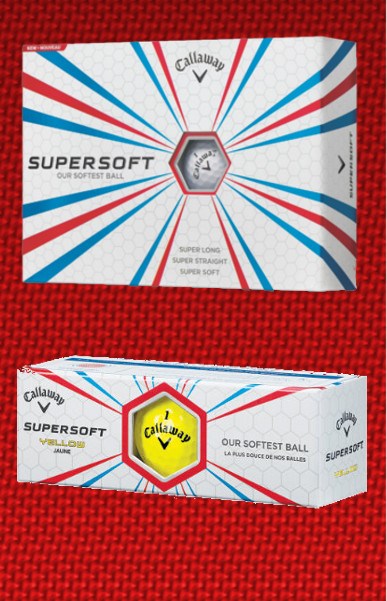
© Callaway Golf
Ball tested: Callaway Supersoft
Category: Value / Recreational / Distance
Feel: Soft
Tested for golfers with average driving distance of: 125 or less to 245 yards (carry + roll)
Specs: Construction – Two-piece; Cover – Trionomer blend; Core – Polybutadiene; Dimples / Pattern – 332 in HEX (hexagonal) design
Compression: Low
Price as tested (new): $21.99 per dozen
Ball notes: Can a soft ball make a hard game easier?
Callaway thinks so. Judging by early returns for the company’s Supersoft golf ball, consumers do, too. Introduced in 2014, the Supersoft quickly became Callaway’s No. 1 seller.
The ball features a zero-compression core wrapped in an extremely soft trionomer cover for a total compression of only 38. That’s comparable to the Wilson Staff DUO, which claims a compression of 29.
What’s the point of all this softness? Longer, straighter drives for golfers with low to average swing speeds, plus great feel and responsiveness around the greens. Let’s see if Callaway’s softest ball ever lives up to its lofty goals.
On the clubface: They certainly got the name right. The Supersoft ball feels as pillowy on contact as any we’ve tried. One of our testers kept looking at his driver after swinging, wondering if the ball had actually stuck to the face. OK, not really. But you get the idea.
The sensation is evident throughout the bag, right down to the shortest putts.
Off the tee: Understand, the Callaway Supersoft is designed for players with slower clubhead speeds – less than 95 mph or so with the driver. Golfers in that range will love its high launch and hang time; they won’t mind the low sidespin, either, since it minimizes slices and hooks. Low backspin also means extra roll for lots of distance.
If you’re in the 100-plus mph club, you may find the Supersoft a bit shorter than higher-compression models.
From the fairway / rough: The Supersoft performed just as well on intermediate shots as it did off the tee. Ball flight is higher than most medium-speed golfers are accustomed to seeing, so shots drop more abruptly and stop very quickly. Faster swingers could find it tough to keep this ball down in the wind, but to reiterate, it’s not designed for them.
Around the green: Balls at this price point aren’t expected to perform as well on chips, pitches and bunker shots. Supersoft definitely exceeds industry standards. Spin, stopping power and versatility are first-rate. As noted, this ball feels wonderful with any club, but it really shines on delicate swings.
Bottom line: Ten years ago, a ball like Callaway’s Supersoft was an engineer’s pipe dream. Now the market is exploding with two-piece balls that feel like the balatas of old, but are far cheaper and more durable. Supersoft delivers everything it promises, and then some. It brings tour-ball performance to the average golfer masses – at 22 bucks a dozen. How ’bout a nice golf clap for Callaway?
Golf Ball Videos:
– Compression Video
– Spin Video
– Dimples Video
– Golf Ball Brands Video
– Titleist Video
– Understanding Spin Video
Categories Explained:
Value/Recreational/Distance – Designed for mid- to high-handicap golfers with swing speeds below 90 mph; typically feature two-piece construction and firm covers; promote greater distance over high spin rates. Examples: Pinnacle Gold, Slazenger RAW Distance
Premium – Designed for low- to mid-handicap golfers with swing speeds of 90-99 mph; typically feature multi-layer construction and medium-soft covers; happy medium between Value/Recreational and Tour categories for distance and spin qualities. Examples: Titleist NXT Tour, Callaway HEX Diablo
Tour/Advanced/Performance – Designed for low-handicap and professional golfers with swing speeds in excess of 100 mph; typically feature multi-layer construction and soft covers; promote greater spin rates and enhanced feel over distance. Examples: Titleist ProV1, Bridgestone Tour B330





